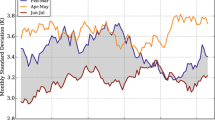Abstract
The results are presented of the statistical analysis of correspondence between the model simulations and observations of temperature changes on the territory of Russia. Three model ensembles are considered, differing in the level of taking account of the impact of external forcings on the climate system of the Earth. For each of them, the statistical correspondence is estimated between the observed surface air temperature variations in the second half of the 20th century and at the beginning of the 21st century and model simulations taking account of the natural variability typical of the climate system. The analysis demonstrated that, in spite of the uncertainties associated with the differences in the representation of anthropogenic and natural external forcings on the climate in model simulations as well as with the imperfection of climate models and with internal variability of the climate system, the model experiments enable to obtain the relevant information both on the temporal evolution of temperature changes on the territory of Russia and on their spatial peculiarities.
Similar content being viewed by others
References
V. A. Govorkova, V. M. Kattsov, V. P. Meleshko, et al., “Climate of Russia in the 21st Century. Part 2. Verification of Atmosphere-Ocean General Circulation Models CMIP3 for Projections of Future Climate Changes,” Meteorol. Gidrol., No. 8 (2008) [Russ. Meteorol. Hydrol., No. 8, 33 (2008)].
G. V. Gruza and E. Ya. Ran’kova, “Assessment of Forthcoming Climate Changes on the Territory of the Russian Federation,” Meteorol. Gidrol., No. 11 (2009) [Russ. Meteorol. Hydrol., No. 11, 34 (2009)].
V. M. Kattsov, V. P. Meleshko, V. A. Govorkova, et al., “Models Intended for Estimating the Future Climate Changes,” in The Assessment Report on Climate Changes and Their Consequences on the Territory of the Russian Federation, Vol. 1: Climate Changes (Rosgidromet, Moscow, 2008) [in Russian].
V. P. Meleshko, V. M. Kattsov, V. M. Mirvis, et al., “Climate of Russia in the 21st Century. Part 1. New Evidence of Anthropogenic Climate Change and the State of the Art of Its Simulation,” Meteorol. Gidrol., No. 6 (2008) [Russ. Meteorol. Hydrol., No. 6, 33 (2008)].
A. F. Siegel, Practical Business Statistics (Izdatel’skii Dom Vil’yams, Moscow, 2002) [Transl. from Engl.].
P. V. Sporyshev, V. M. Mirvis, V. M. Kattsov, et al., “Anthropogenic Contribution to the Climate Change,” in The Assessment Report on Climate Changes and Their Consequences on the Territory of the Russian Federation, Vol. 1: Climate Changes (Rosgidromet, Moscow, 2008) [in Russian].
B. E. Shneerov, V. P. Meleshko, V. A. Matyugin, et al., “Current State of the Global Atmosphere General Circulation Model (MGO-2 Version),” Trudy GGO, Vypusk 550 (2001) [Trans. Main Geophysical Observatory, Issue 550 (2001)].
B. E. Shneerov, V. P. Meleshko, A. P. Sokolov, et al., “MGO Global Model of Atmosphere/Upper Ocean Layer Circulation,” Trudy GGO, Vypusk 544 (1997) [Trans. Main Geophysical Observatory, Issue 544 (1997)].
O. Boucher and M. Pham, “History of Sulfate Aerosol Radiative Forcings,” Geophys. Res. Lett., 29 (2002).
P. Brohan, J. J. Kennedy, I. Harris, et al., “Uncertainty Estimates in Regional and Global Observed Temperature Changes: A New Dataset from 1850,” J. Geophys. Res., 111 (2006).
S. Geisser, Predictive Inference: An Introduction (Chapman & Hall, New York, 1993).
I. Hansen, M. Sato, L. Nazarenko, et al., “Climate Forcings in Goddard Institute for Space Studies SI2000 Simulations,” J. Geophys. Res., 107 (2002).
J. W. Hurrell, J. J. Hack, D. Shea, et al., “A New Sea Surface Temperature and Sea Ice Boundary Dataset for the Community Atmosphere Model,” J. Climate, 21 (2008).
R. Knutti, G. Abramowitz, M. Collins, et al., “Good Practice Guidance Paper on Assessing and Combining Multi Model Climate Projections,” in Meeting Report of the Intergovernmental Panel on Climate Change Expert Meeting on Assessing and Combining Multi Model Climate Projections (IPCC Working Group I Technical Support Unit, University of Bern, Bern, Switzerland, 2010).
R. E. Livezey and W. Y. Chen, “Statistical Field Significance and Its Determination by Monte Carlo Techniques,” Mon. Wea. Rev., 111 (1983).
D. S. Wilks, “On “Field Significance” and the False Discovery Rate,” J. Appl. Meteorol. Climatol., 45 (2006).
C. J. Willmott and S. M. Robeson, “Climatologically Aided Interpolation (CAI) of Terrestrial Air Temperature,” Int. J. Climatol., No. 2, 15 (1995).
Author information
Authors and Affiliations
Additional information
Original Russian Text © P.V. Sporyshev, V.M. Kattsov, V.A. Matyugin, 2012, published in Meteorologiya i Gidrologiya, 2012, No. 1, pp. 5–19.
About this article
Cite this article
Sporyshev, P.V., Kattsov, V.M. & Matyugin, V.A. A correspondence between the model ensemble simulations and observations of temperature changes on the territory of Russia. Russ. Meteorol. Hydrol. 37, 1–11 (2012). https://doi.org/10.3103/S1068373912010013
Received:
Published:
Issue Date:
DOI: https://doi.org/10.3103/S1068373912010013



